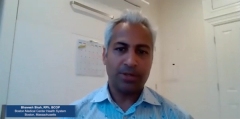
SYK Inhibitors as Immune Thrombocytopenia Treatment
Episodes in this series

The rationale behind the study of SYK inhibitors as treatment for patients with persistent and chronic immune thrombocytopenia who have failed to respond or relapsed after prior therapy.
Bhavesh Shah, RPh, BCOP: Layering on top of the guidelines and going back to the SYK inhibitor, a lot of providers may not understand the mechanism of a SYK inhibitor. Do you want to talk about the mechanism and its implications in practice?
David Hughes, PharmD, BCOP: That’s a great question, Bhavesh. The most important point to recognize when thinking about SYK inhibitors is, as we talked before about targeting ITP [immune thrombocytopenia] from a destruction standpoint by using corticosteroids or IVIg [intravenous immunoglobulin], and then from a production standpoint, meaning that TPO, or thrombopoietin, receptor agonists are used to stimulate the production.
SYK, or spleen tyrosine kinase, is a key molecule that’s intracellularly activated in the key part of the process of phagocytosis within the cell of any antibody-mediated complex. In this case, with ITP, you have production of auto-antibodies, which bind to platelets. That binding facilitates a release of macrophages from the spleen that will target this complex. The binding of that macrophage to this complex is mediated by binding to the Fc gamma receptors and, ultimately, a signal transduction pathway that’s utilized via the SYK pathway. Once that’s phosphorylated, you see an activation and a phagocytosis effect to eradicate that tagged platelet from the body. Ultimately in ITP, if we can find a way to target that SYK transduction and inhibit that process, we can have these tagged antibodies continue to circulate without being destroyed and removed from the body by these macrophages. It is definitely a newer novel mechanism, and many other drugs are looking into a similar pathway. But ultimately, SYK inhibitors are the first drug that’s become available that targets this unique pathway of the disease itself, as opposed to destroying either the auto-antibodies that are currently circulating or producing using an exogenous TPO agonist.
Bhavesh Shah, RPh, BCOP: Wow, so it’s a unique mechanism. Before, we were targeting only platelet production. Now we’re targeting platelet destruction. It’s a unique, novel mechanism for this drug.
Newsletter
Stay informed on drug updates, treatment guidelines, and pharmacy practice trends—subscribe to Pharmacy Times for weekly clinical insights.



























































































































































































































